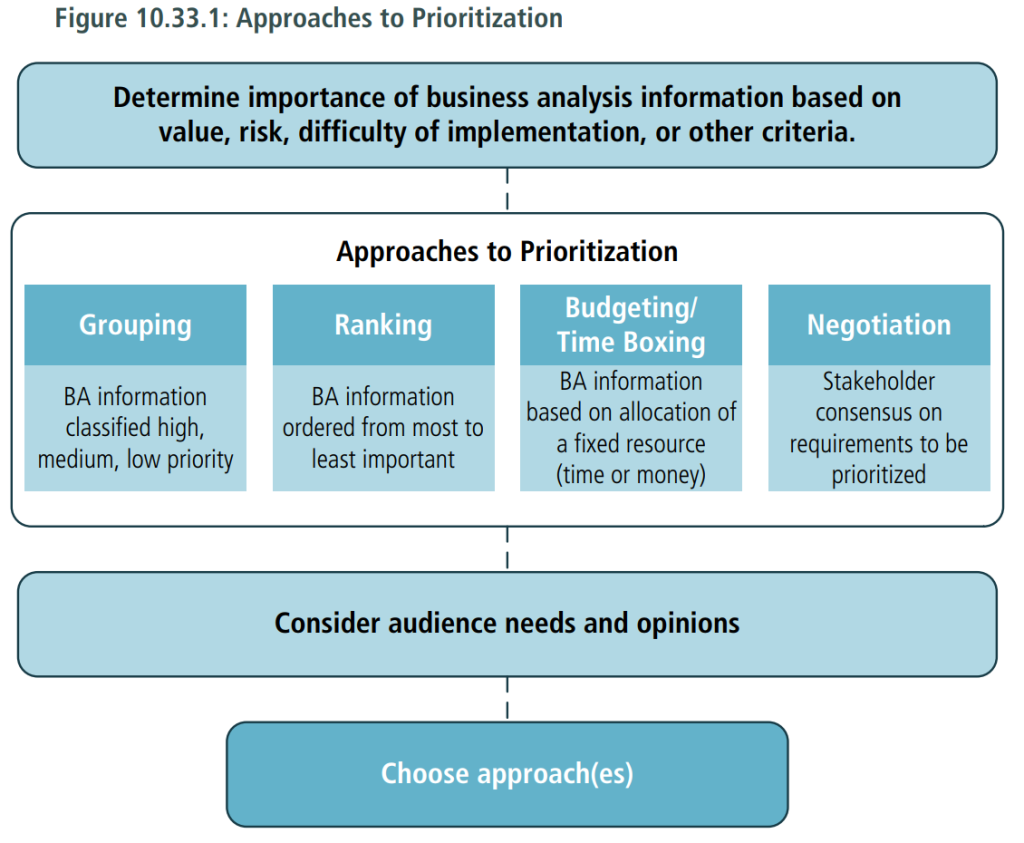10.33.1 Purpose
Prioritization provides a framework for business analysts to facilitate stakeholder decisions and to understand the relative importance of business analysis information.
10.33.2 Description
Prioritization is a process used to determine the relative importance of business analysis information. The importance may be based on value, risk, difficulty of implementation, or other criteria. These priorities are used to determine which business analysis information should be targeted for further analysis, which requirements should be implemented first, or how much time or detail should be allocated to the requirements.
There are many approaches to prioritization. For the purpose of this technique, prioritization is classified into one of four approaches:
- Grouping,
- Ranking,
- Time boxing/Budgeting, and
- Negotiation.
When choosing a prioritization approach, business analysts consider the audience, their needs, and their opinions on the value a requirement or business analysis information brings to a stakeholder’s respective area.
Business analysts revisit priorities and utilize different approaches when changes occur in the business environment, to the stakeholders, and to the business analysis information.

10.33.3 Elements
.1 Grouping
Grouping consists of classifying business analysis information according to predefined categories such as high, medium, or low priority. Many requirements management tools support listing the priority category as an attribute of a requirement.
.2 Ranking
Ranking consists of ordering business analysis information from most to least important. Some adaptive approaches involve the explicit sequencing of requirements in an ordered list (a product backlog).
.3 Time Boxing/Budgeting
Time boxing or budgeting prioritizes business analysis information based on the allocation of a fixed resource. It is frequently used when the solution approach has been determined. Time boxing is used to prioritize requirements based on the amount of work that the project team is capable of delivering in a set period of time. Budgeting is used when the project team has been allocated a fixed amount of money. This approach is most often used when a fixed deadline must be met or for solutions that are enhanced on a regular and frequent basis.
.4 Negotiation
The negotiation approach involves establishing a consensus among stakeholders as to which requirements will be prioritized.
10.33.4 Usage Considerations
.1 Strengths
- Facilitates consensus building and trade-offs and ensures that solution value is realized and initiative timelines are met.
.2 Limitations
- Some stakeholders may attempt to avoid difficult choices and fail to recognize the necessity for making trade-offs.
- The solution team may intentionally or unintentionally try to influence the result of the prioritization process by overestimating the difficulty or complexity of implementing certain requirements.
- Metrics and key performance indicators are often not available when prioritizing business analysis information; therefore, a stakeholder’s perspective of the importance may be subjective.
